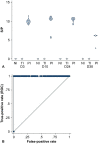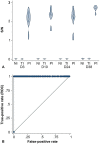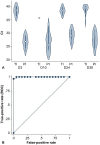Effect of calf age on bovine viral diarrhea virus tests
- PMID: 33666123
- PMCID: PMC8120083
- DOI: 10.1177/1040638721998821
Effect of calf age on bovine viral diarrhea virus tests
Abstract
Bovine viral diarrhea virus (BVDV) causes significant economic loss in cattle. Detection of persistently infected (PI) animals is an important control measure, but persistence of maternal antibodies may result in false-negative test results. We assessed the sensitivity and specificity of 2 antigen ELISAs (Idexx BVDV Ag/Serum Plus and BVDV PI X2) and a reverse-transcription real-time PCR (RT-rtPCR; Idexx RealPCR BVDV) assay for detecting PI calves. Ear notch samples were collected from 1,030 calves ~3, 10, 24, and 38 d old (days 3, 10, 24, and 38). All day 38 samples were tested using 2 antigen ELISAs and RT-rtPCR, and any calf that tested positive by any of these tests was blood sampled at ~100 d old (day 100) for antigen and antibody testing by ELISA; samples collected on days 3, 10, and 24 were tested using the antigen ELISAs and PCR. Calves were defined as PI if they were test-positive on day 38 by either ELISA or PCR and were antigen-positive on day 100. Twenty-six calves were PCR BVDV test-positive and one was BVDV PI X2 ELISA-positive at day 38. Five calves were defined as PI, and all tested positive by ELISAs and RT-PCR assay on days 3, 10, and 24. The sensitivity and specificity were 100% for both antigen ELISAs and 96.7% and 100%, respectively, by RT-rtPCR. Test results were not affected by calf age, suggesting that testing for PI calves can be undertaken at any age.
Keywords: ELISA; PCR; bovine viral diarrhea virus; calf; sensitivity; specificity.
Conflict of interest statement
Figures





References
-
- Barrett D, et al.. Herd-level factors associated with detection of calves persistently infected with bovine viral diarrhoea virus (BVDV) in Irish cattle herds with negative herd status (NHS) during 2017. Prev Vet Med 2020;179:104990. - PubMed
-
- Brar JS, et al.. Maternal immunity to infectious bovine rhinotracheitis and bovine viral diarrhea viruses: duration and effect on vaccination in young calves. Am J Vet Res 1978;39:241–244. - PubMed
-
- Brownlie J. The pathways for bovine virus diarrhoea virus biotypes in the pathogenesis of disease. Arch Virol Suppl 1991;3:79–96. - PubMed
-
- Bruschke CJM, et al.. The immune response of cattle, persistently infected with noncytopathic BVDV, after superinfection with antigenically semi-homologous cytopathic BVDV. Vet Immunol Immunopathol 1998;62:37–50. - PubMed
MeSH terms
Substances
LinkOut - more resources
Full Text Sources
Other Literature Sources
Research Materials
Miscellaneous

